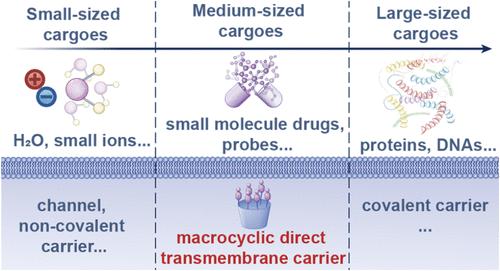单分子大环载体克服中型货物的直接跨膜
IF 15.6
1区 化学
Q1 CHEMISTRY, MULTIDISCIPLINARY
引用次数: 0
摘要
直接跨膜转运在生物医学领域发挥着重要作用。尽管已有成熟的方法可用于小尺寸货物(如水和离子)和大尺寸货物(如蛋白质、dna、多糖)的直接膜运输,但它们难以直接应用于中型货物(如药物、探针、寡肽和生长激素)。在这里,我们提出了一种带负电荷的单分子载体,羧基修饰偶氮杂环芳烃(CAC6A),作为一种直接的跨膜工具,促进了中型货物的运输。利用药物抑制剂确定了CAC6A的细胞摄取途径,并证实了直接跨膜转运。进一步的转运机制研究表明,CAC6A的上缘修饰基团、空腔大小和适当的两亲性促进了直接的膜转运。结合低氧响应特性,CAC6A实现了有效载荷的靶向释放。这项工作的发现可能会导致基于大环的跨膜系统的发展,在生物医学,诊断和传感领域具有广泛的应用。本文章由计算机程序翻译,如有差异,请以英文原文为准。

Single-Molecule Macrocyclic Carrier Overcomes the Direct Transmembrane of Medium-Sized Cargoes
Direct transmembrane transport plays an important role in the biomedical field. Although well-established methods exist for the direct membrane transport of small-sized cargoes (e.g., water and ions) and large-sized cargoes (e.g., proteins, DNAs, polysaccharides), they are challenging to directly apply to medium-sized cargoes (e.g., drugs, probes, oligopeptides, and growth hormones). Here, we present a negatively charged single molecular carrier, carboxyl-modified azocalix[6]arene (CAC6A), as a direct transmembrane tool that facilitates the transport of medium-sized cargoes. The cellular uptake pathway of CAC6A was identified using pharmacological inhibitors, and the direct transmembrane transport was confirmed. Further mechanistic transport investigations reveal that the modification group at the upper rim, the cavity size, and the appropriate amphiphilicity of CAC6A promote direct membrane transport. Combined with the hypoxia-responsive property, CAC6A achieved the targeted release of the payload. The findings in this work may lead to the development of macrocycle-based transmembrane systems with broad applications in biomedicine, diagnostics, and sensing.
求助全文
通过发布文献求助,成功后即可免费获取论文全文。
去求助
来源期刊
CiteScore
24.40
自引率
6.00%
发文量
2398
审稿时长
1.6 months
期刊介绍:
The flagship journal of the American Chemical Society, known as the Journal of the American Chemical Society (JACS), has been a prestigious publication since its establishment in 1879. It holds a preeminent position in the field of chemistry and related interdisciplinary sciences. JACS is committed to disseminating cutting-edge research papers, covering a wide range of topics, and encompasses approximately 19,000 pages of Articles, Communications, and Perspectives annually. With a weekly publication frequency, JACS plays a vital role in advancing the field of chemistry by providing essential research.

 求助内容:
求助内容: 应助结果提醒方式:
应助结果提醒方式:


